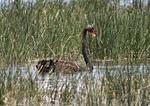| Home | About BFIS | Species List | Risk Analysis | Harmonia⁺ | Resources | Outputs | Mailing List | Registry |
| Contact us | Login | | ||||||
 |

©
J.T. Ratcliff

©
Arthur Chapman

©
Karora
 Naturalization in Belgium Naturalization in Belgium
 Invasiveness Invasiveness
More on invasiveness: Although it is known to make dense colonies in its native range, the black swan does not seem to expand rapidly its populations in Belgium, probably as a consequence of frost sensitivity. Situation is likely to change due to climate warming. In Belgium, nesting habitat consists of marshy clay and gravelpits, ponds with riverine vegetation, old river arms and canals.
 Distribution in Belgium Distribution in Belgium
Established populations

 Impacts on Species Impacts on Species
 Impacts on Ecosystems Impacts on Ecosystems
More on impacts: Dense colonies may impair the development of submerged vegetation and outcompete native water birds from nesting sites. They are also likely to affect ecosystem functions.
References:
Dubois, P.J. (2007)
Ornithos 14: 329-364.
Hill, M. et al. (2009)
Developing an indicator of the abundance, extent and impact of invasive non-native species. Final report.
 Defra, 49pp. (WC0718)
Jacob, J.P. et al. (Eds) (2009)
Atlas des oiseaux nicheurs de Wallonie.
Aves et Centre de Recherche de la Nature, des Forêts et du Bois (MRW, DGRNE), Série "Faune-Flore-Habitats".
Kumschick, S. & Nentwig, W. (2010)
Biological Conservation 143(11): 2757-2762.
Mitchell, S.F. & Wass, R.T. (1996)
Grazing by black swans (Cygnus atratus Latham), physical factors, and the growth and loss of aquatic vegetation in a shallow lake.
 Aquatic Botany 55(3): 205-215.
Owen, M., Callaghan, D. & Kirby, J. (2006)
AEWA Technical Series No.12, Bonn, Germany.
Vermeersch, G. & Anselin, A. (2009)
Broedvogels in Vlaanderen 2006-2007. Recente status en trends van Bijzondere Broedvogels en soorten van de Vlaamse Rode Lijst en/of Bijlage I van de Europese Vogelrichtlijn.
Mededelingen van het Instituut voor Natuur- en Bosonderzoek, Brussels, 99 pp.
Vermeersch, G., Anselin, A., Devos, K. , Herremans, M., Stevens, J., Gabriëls, J. & Van der Krieken, B. (2004)
Atlas van de Vlaamse broedvogels 2000-2002.
Mededelingen van het Instituut voor Natuurbehoud 23, Brussel, 495 pp.
Weiserbs, A. & Derouaux, A. (2009)
Elaboration de plans d'action pour des espèces problématiques dans la région de Bruxelles-Capitale : les espèces d'oiseaux d'eau naturalisées et domestiquées retournées à l'état sauvage.
Rapport technique, Aves, 57 pp.
Weiserbs, A. & Jacob, J.P. (2007)
Oiseaux nicheurs de Bruxelles 2000-2004: répartition, effectifs, évolution.
Aves, Liège, 292 pp.
|
 |
 |




